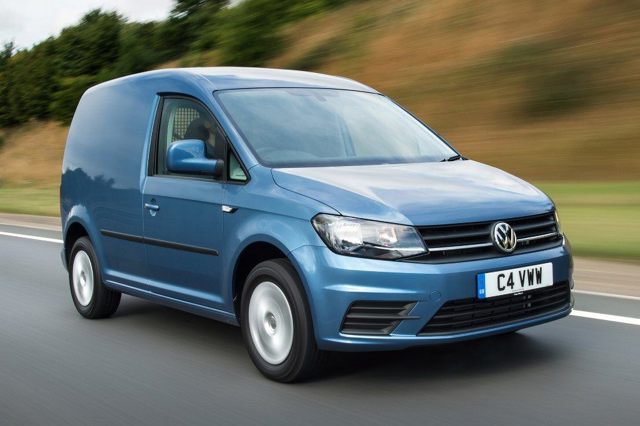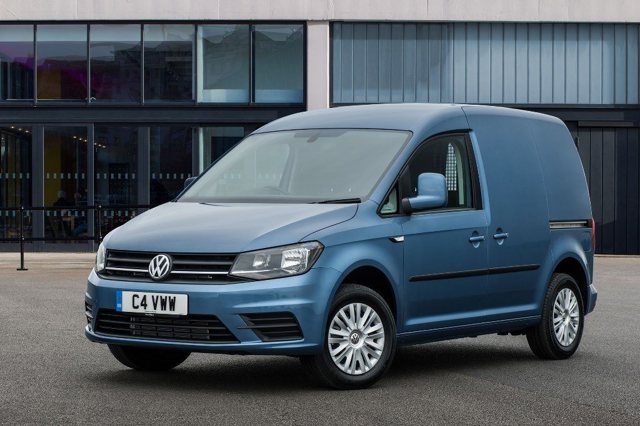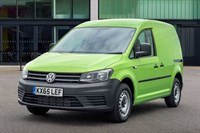Volkswagen Caddy (2015 – 2021) Review
Volkswagen Caddy (2015 – 2021) At A Glance
The new fourth generation Caddy may appear to be just a facelifted model at first glance, but Volkswagen has made some significant changes beyond the aesthetics. An all-new interior further bolsters the Caddy’s position of being one of the best in its class when it comes to quality and driver comfort.
Despite a familiar silhouette it is only the cargo area that has remained largely the same, mainly so that existing owners will be able to transfer any specific interior fit-outs with ease.
As with its predecessor the Volkswagen Caddy is available in standard and long wheelbase - called the Caddy Maxi - versions, both of which are available with a number of rear-door options. Most buyers will opt for the standard front-wheel drive model, though for those who venture into more remote locations the Caddy is also available with 4Motion all-wheel drive.
There is a choice of four diesel engines in the Caddy range, all 2.0 TDI units. Power outputs range from the entry-level 75PS through to 102PS and 122PS, right up to a range-topping 150PS version. Depending on power output the Caddy comes equipped with either a five or six-speed manual gearbox as standard, while there's an optional automatic DSG. The Caddy has also been sold with a broad range of 1.0, 1.2 and 1.4 TSI petrol engines.
All engines are Euro 6 compliant, thanks in part to AdBlue technology, and come equipped with Volkswagen’s BlueMotion systems to help reduce fuel consumption. According to official figures the 102PS van is the most efficient Caddy, returning an official 72.3mpg, while emissions are rated at just 99g/km.
In standard form the Caddy can carry a cargo load of up to 3.2 cubic metres while the Caddy Maxi can carry up to 4.2 cubic metres - both can accommodate a Euro pallet lengthways. That's the same as before which means the Caddy still lags behind the competition when it comes to outright carrying ability. The Transit Connect is easier to load and has a bigger payload.
In comparison to some of its rivals the Caddy does carry a price premium but it’s easy to see just where the Volkswagen rises above the rest when it comes to quality and refinement.
Driving the Volkswagen Caddy (2015 – 2021)
Volkswagen’s base 75PS engine offers reasonable performance with 225Nm of torque though a five-speed manual gearbox limits its ability at motorway speeds. This engine is best suited to those who generally stick to urban routes and don’t have the need to transport very heavy loads.
The 102PS 2.0 TDI Caddy, with its 250Nm of torque, offers a better blend of performance and economy, returning 67.2mpg with emissions of 109g/km. It pulls well and delivers decent power and overall drivability.
The 122PS engine exclusively comes with the 4Motion all-wheel drive system, making the Caddy feel particularly surefooted on the road. The top 150PS engine is the one to go for if a lot of towing is on the cards. Its 340Nm of torque arrives at 1,750rpm thus ensuring enough pulling power to haul up to 1,500kg. Unhitched from a load this engine gives the Caddy a top speed of 125mph and a 0-62mph time of 9.2 seconds, illustrating its performance.
Volkswagen added petrol-powered to the Caddy line-up in 2015 with buyers getting the option of the three-cylinder 1.0 TSI with 102PS, alongside the 84PS 1.2 and 125PS 1.4-litre engines.
The 1.4TSI that stands out as the best petrol Caddy option, with superb refinement and torque. In terms of price and performance it’s similar to the 102PS 2.0-litre TDI diesel and comes very close to matching the 2.0 diesel for torque (250Nm), with 220Nm available from 1500rpm. Admittedly, its official 47.9mpg is short on the diesel’s 61.4mpg, but the Caddy still has plenty of appeal for van drivers who cover short distances.
One of the most appealing factors about the Caddy is how well it drives, feeling much more like a passenger car than a van. Revisions to the suspension setup both front and rear further enhance this. Even when on less well-paved tarmac and without carrying a load, the Caddy holds the road well when others can feel unsettled. The steering is well weighted, while in traffic a light clutch pedal and short throw when changing gears makes it less tiresome to drive. A well-insulated cabin that feels spacious further complements this.
Thanks to great all-round visibility and generously-sized side mirrors the Volkswagen is easy to navigate around narrow streets while a good turning circle helps its manoeuvrability - even in the case of the Caddy Maxi’s longer wheelbase. The new Caddy also now comes with cruise control and a speed limiter as standard.
The cabin has received a complete redesign and features higher quality materials across all four trim grades. There are also numerous storage areas throughout the cabin including an overhead shelf. On top of all that, it is now the only van in its segment to offer both driver and passenger front airbags along with side and curtain airbags.
Volkswagen Caddy (2015 – 2021) interior
The load area of this new fourth-generation Caddy has remained the same as its predecessor, which will be good news to those who might want to transfer an existing storage setup.
The standard van can take a load volume of up to 3.2m3 while the Caddy Maxi can swallow up to 4.2cubic metres. There are two asymmetrical doors at the rear that open to 90 degrees and can be unlatched to a further 180 degrees.
On the passenger side there is one sliding door with a 700mm opening and if required a second sliding door can be specified. It is possible to order a single tailgate too, but it quite large and isn’t as practical to use especially when in tighter spaces.
Inside, there are six lashing rings (eight in the Caddy Maxi) and the addition of new solid axles has meant that the maximum payload is 736kg. It doesn’t make it the class leader - the Transit Connect will shift up to 1000kg - but the Caddy is a good all-rounder .
The space between the wheelarches can handle objects up to 1172mm although there is no high roof option. A further ‘Flex-Seat’ option on the passenger side gives the ability to fold it into the floor to increase the overall load length to 3070mm.
Volkswagen Caddy (2015 – 2021) models and specs
| Dimensions | |
|---|---|
| Length | 4406–4876 mm |
| Width | 1794–2062 mm |
| Height | 1823–1841 mm |
| Load Volume | 3.2–4.2 m3 |
| Miscellaneous | |
|---|---|
| Kerb Weight | 1451–21531 kg |
| Payload | 547–735 kg |
| Warranty | 3 years / 100000 miles |
| Servicing | 18000 |
Maxi Panel Van
Panel Van
Model History
- February 2015: New Volkswagen Caddy unveiled
- May 2015: Caddy gets autonomous emergency braking as standard
- June 2015: Prices for new Caddy announced
- November 2015: New Euro 6 engines added
- December 2015: Petrol engine launched in Caddy
- June 2017
February 2015
New Volkswagen Caddy unveiled
The Caddy range is powered by new 2.0-litre, four cylinder diesel engines. The performance range includes 75PS, 102PS and the top-of-the-range engine a 150PS.
Numerous new safety and comfort features protect the occupants and support the driver. One of these is the ‘Front Assist’ surroundings monitoring system, including City Emergency Braking. If the driver fails to see an obstacle below a speed of 19 mph, the system automatically applies the brakes, aiming to prevent any collisions. In the passenger carrying variant, Caddy Life, occupants are protected by the use of side and curtain airbags.
For the first time on Caddy, there is the option of Adaptive Cruise Control (ACC), which is active at speeds of 0-100mph with DSG or 19-100mph with a manual transmission – and uses radar sensors to monitor the distance and relative speed to vehicles in front. When used in conjunction with DSG, the ACC system can also slow the vehicle down, for example in queues or traffic jam situations, to a complete stop.
May 2015
Caddy gets autonomous emergency braking as standard
Volkswagen the first commercial vehicle brand to fit all its vans with autonomous emergency braking systems (Front Assist with City Emergency Braking), meaning all customers ordering a new Caddy, Transporter or Crafter van from 1 June will be guaranteed safety as standard.
Using a radar built into the front end of the van, Front Assist recognises critical distances to the vehicle in front and helps to ensure safe stopping. In any dangerous situations Front Assist reacts here in two stages: in the first the assistance system warns the driver with audible and visual signals of any vehicle in front driving slowly or suddenly braking and of the associated risk of collision. In parallel it gets the vehicle ready for emergency braking – by applying the brake pads and alerting the brake assistant. If the driver fails to react to the warning, a one-off short jolt of the brake indicates in the second stage the looming danger of a collision and the brake assistant’s responsiveness is further increased. If the driver then hits the brakes, full braking power is immediately available. If the driver does not brake strongly enough, Front Assist increases the braking pressure to the required level, so that the vehicle comes to a stop before reaching the obstacle.
The system also includes the City Emergency Braking function, which provides assistance at low speeds of under 18 mph. If the driver fails to see or react to an obstacle, the system automatically applies the brakes and ensures that the speed of any collision is reduced. Ideally, it completely prevents the vehicle from running into the obstacle.
June 2015
Prices for new Caddy announced
Prices start at £13,500 (excl. VAT) for the C20 Startline short wheelbase model with a 2.0 TDI 75 PS engine.
The new Caddy is available in three trim levels – Startline, Trendline and Highline – and with short or Maxi wheelbases. The Maxi version adds 469 mm to the short wheelbase’s already generous 1,781 mm and a load capacity of 4.2m3 (SWB 3.2m3).
The entry-level Startline model comes with an impressive array of standard equipment, including electric windows and heated and electrically adjustable wing mirrors, a five-inch touchscreen Composition Colour radio system with DAB+ and Bluetooth capability, a lockable glovebox, plus safety features such as driver and front passenger front, side and curtain airbags, a new post-collision braking system and a seatbelt reminder.
Moving up the range, Trendline, with prices starting from £15,670 adds full wheel covers, body coloured bumpers, handles and wing mirrors, rear parking sensors, cruise control, multi-function display, driver’s lumbar support, under-seat storage and sun visors with vanity mirrors.
At the top of the range, Highline, from £16,650, gains alloy wheels, front fog lights and daytime running lights, Climatic air conditioning, heated front windscreen, automatic dimming rear-view mirror, Thatcham category 1 alarm and windscreen wipers with intermittent control and rain sensor.
At launch the Caddy is offered with a range of three 2.0-litre EU5 engines, ranging in power output from 75PS through 102PS to 150PS. An EU6 compliant 2.0-litre unit with 102PS is also available from launch. All models are available in combination with a five- or six-speed manual gearbox, with customers of the higher powered versions can also opt for a DSG automatic gearbox option (with six- or seven-speeds depending on engine power output).
November 2015
New Euro 6 engines added
Prices start at £13,500 (excl. VAT and OTR charges) for the C20 Startline short wheelbase model with a 2.0-litre TDI 75 PS Euro 6 engine.
The new engines are a 2.0 TDI 75PS and 2.0 TDI 150PS. These new engines are available across all three trim levels – Startline, Trendline and Highline - on the short wheelbase model. The Caddy Maxi (longer wheelbase) version adds the 2.0 TDI 150PS engine to its line-up. The 2.0 TDI 102PS Euro 6 engine, that has been available since the launch of the new Caddy earlier in the year, is still offered on both the Caddy and Caddy Maxi models.
The Euro 6 models have BlueMotion Technology as standard, giving the customer low rolling resistance tyres, start/stop system, hill hold assist and regenerative braking.
December 2015
Petrol engine launched in Caddy
Prices start from £13,610 (excluding VAT) for the 1.2 TSI 84PS 5-speed Caddy panel van Startline model, from £15,110 for the 1.2 TSI 84PS.
The new Euro 6 petrol engine range will consist of a 1.2 84PS 5-speed manual, a 1.0 102PS 5-speed manual and a 1.4 125PS with either the 6-speed manual or 7-speed DSG gearbox available on both Caddy panel van and Caddy Life.
June 2017
Specification improvements and a price reduction announced for Volkswagen Caddy vans. The change delivers higher standard equipment levels, boosted safety features across all models and lower prices for petrol-powered models.
For the 2018 model, Volkswagen Commercial Vehicles has increased safety levels with the fitment of autonomous emergency braking (AEB - Front Assist with City Emergency Braking) and driver alert as standard across the entire range. All Volkswagen vans now come with standard AEB.
All three trim grades, Startline, Trendline and Highline, feature more standard equipment than before. All gain a leather multifunction steering wheel and multifunction display (in addition to AEB and Driver Alert), while 2018 Trendline models now feature climatic air conditioning as standard. Highline models gain Volkswagen’s Discover Media satellite navigation system as standard.
As part of the 2018 Caddy package, Volkswagen also realigned its price structure. The Startline 1.2 TSI 84 PS model now costs £17,527 (total RRP inc OTR and VAT): £1,017 less than the previous price.
The Caddy is offered with three highly efficient TSI petrol units. The line-up for the 2018 model consists of: a 1.2-litre 84 PS four-cylinder unit, a 1.0-litre 102 PS three-cylinder unit and a range-topping 1.4-litre 125 PS four-cylinder engine offered with the option of a seven-speed DSG transmission. All three optimise lightweight construction and a turbocharger.
All Caddy vans ordered from 1 June will be equipped with the new specification package.





.jpg?width=640&height=426&rmode=crop)
.jpg?width=640&height=426&rmode=crop)

 Impressive 2.0 TDI engine, excellent refinement,
Impressive 2.0 TDI engine, excellent refinement,
 A thorough revamp rather than an all-new van, cargo area is still limited compared to the competition.
A thorough revamp rather than an all-new van, cargo area is still limited compared to the competition.
